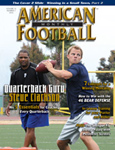Article CategoriesAFM Magazine
|
HERO TO ZERO IN ONE PLAY: Drilling the Defensive Back for Confidenceby: Tony BrinsonTight Ends Coach, Columbia University © More from this issue While I am now coaching tight ends at Columbia University, I have spent many seasons as a defensive backs coach. If anyone has been a secondary coach or played the position before, you are intimately familiar with those times when, in the final seconds of a game, an intercepted pass can “seal the deal” for your team or where a deep bomb can spell misery. The positive end result of those times is a combination of competitiveness, but more importantly, reliance on solid fundamentals. I have heard coaches talk about teaching progressions, but how many actually have an orderly teaching progression that they adhere to? Defenses will be tested throughout a game by the deep ball and the nature of the position dictates that any mistakes usually result in six points. Schematics only get you so far. Having a core teaching progression built from ....The full article can only be seen by subscribers.
|
|
|||||||
| HOME |
MAGAZINE |
SUBSCRIBE | ONLINE COLUMNISTS | COACHING VIDEOS |
Copyright 2025, AmericanFootballMonthly.com
All Rights Reserved





